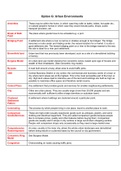Interview
IB Geography - Option G: Urban environments ( straight 7)
- Course
- Institution
These notes have been written together with my teacher (20-years of IB geography teaching), and exactly match the syllabus. They perfectly resume the syllabus in a well-organized and clear way using diagrams, images, colours, etc. They got me a straight 7 on all papers as they contain all the infor...
[Show more]



